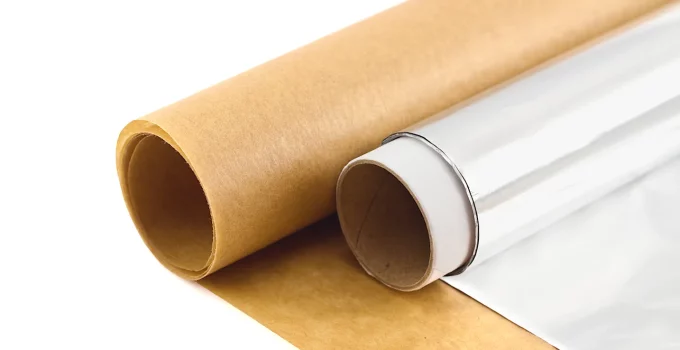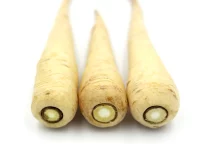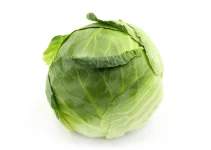There are several reasons for looking for the best alternatives to aluminum foil.
One of the most important reasons for wanting to use something else besides aluminum foil is that you simply don’t want metal touching your food, which is totally understandable.
For example, whenever I need to wrap something in foil to cook it in the oven or on the grill or I need to cover a baking sheet with foil, I first apply a layer of parchment paper and then put the aluminum foil on top.
I totally know that it can only increase the aluminum content in our diet by a small amount but I still prefer doing the parchment paper + aluminum foil on top combo when I need to.
Another reason for looking for substitutes to aluminum foil is that it isn’t nonstick. Thus, if we use it to line our baking sheet with it, food will stick to foil. Parchment paper is the non-stick one of the two.
Last but not least, we live in an era when most of us like to take the environment into consideration when making decisions about which products we should use and which should be banished from our kitchens and households.
Thus, we’re also going to talk about the fact that some might prefer looking for aluminum foil substitutes as a consideration for the planet we live on.
Table of Contents
Favorite Alternatives to Aluminum Foil
1. Parchment paper: Reynolds Kitchens Unbleached Parchment Paper Roll
This is one of my favorite alternatives to aluminum oil. It’s also heat resistant but it’s also non-stick, which foil isn’t. Moreover, if you don’t want your food to come in contact with aluminum foil, add parchment paper first and the wrap it in foil.
2. Silicone baking mats: Silpat Premium Non-Stick Silicone Baking Mat
Silicone baking mats are also non-stick and heat-resistant so they can be used on baking sheets to bake on. They’re less versatile than parchment paper and we can’t wrap food in silicone baking mats to cook it.
3. Glass food storage containers: Pyrex 10-Piece Glass Food Storage Container Set
If you use foil to store food in the fridge, then using glass food storage containers is the perfect alternative.
4. Recycled aluminum foil: Reynolds Wrap Recycled Aluminum Foil
If there’s no viable alternative to aluminum foil but you’re concerned about the environment, then you could choose to use recycled foil. The price difference is not considerable.
5. Lunch box: LunchBots Stainless Steel Lunch Container
Another interesting option for storage is getting a lunch box. This is a perfect alternative for those who are looking for an alternative to aluminum foil for packing up their lunch or food for when they’re away from home.
The Best Alternatives to Aluminum Foil
Besides going into making comparisons between aluminum foil vs parchment paper or talking about whether tin foil is eco-friendly or not, let’s go over some of the best alternatives to aluminum foil.
There are not that many substitutes. However, you’ll have to decide which works best for you depending on the situations you’re using it for.
We can divide the situations in which we use tin foil into two main categories: when we’re baking/grilling/broiling and when we’re storing food.
Thus, if we need substitutes for cooking, then we can use parchment paper, biodegradable parchment paper, silicone baking mats or even recycled aluminum foil.
If we need alternatives for storing food, then we can use recycled aluminum foil, glass storage containers, beeswax food wraps or silicone lids.
1. Parchment Paper: Best Alternative to Aluminum Foil for Baking
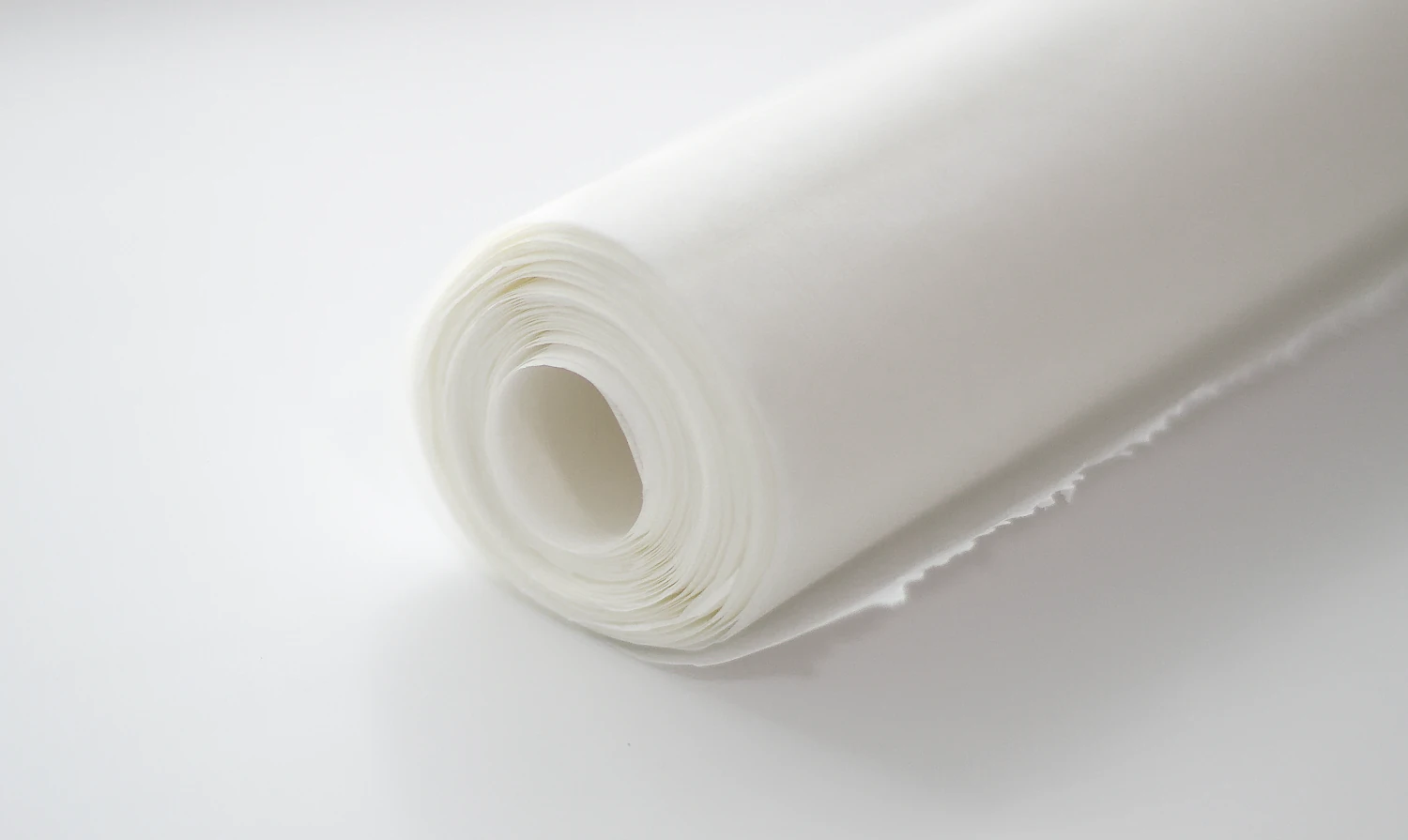
Parchment paper is one of my favorite things to use in the kitchen when I’m baking or when I’m using my air fryer.
If you want to line your baking sheet with an easy-to-use thing, you need to use parchment paper.
There are two main attributes that make it so good and so highly used in the kitchen: it’s non-stick and it’s heat resistant.
While aluminum foil is also heat resistant, which is totally obvious because it’s made of metal, it’s not non-stick.
So, if we line a baking sheet or Dutch oven or any other baking dish with aluminum foil instead of parchment paper, then the food is going to stick to the foil.
Of course, we can grease the foil or spray it with non-stick oil spray to prevent sticking.
But the beauty of using parchment paper is that we don’t have to grease it or spray it with anything because it’s inherently nonstick without us doing anything more than laying it out in the pan until it matches the size and shape we need.
Using parchment paper + aluminum foil combo
If we grill or broil, then that’s when we need to use aluminum foil.
We can’t use only parchment paper in that situation because aluminum foil conducts and distributes heat and it can withstand high temperatures, above 400 degrees F.
What we can use if we don’t want our food to directly touch the foil is to first use parchment paper and spread out the foil over parchment paper.
Thus, parchment paper is not designed for cooking at temperatures over 450 degrees F but it can be used as a protective layer between our food and the foil, if that’s what we would prefer.
Another good reason for first laying out parchment paper and then covering it with foil is that it presents the possibility of keeping the foil clean.
Thus, if our foil is clean after using it in the oven, then we can reuse that foil on another occasion(s), which implies sustainability.
Where to Buy?
Check Price and User Reviews Here
2. Biodegradable (Unbleached) Parchment Paper
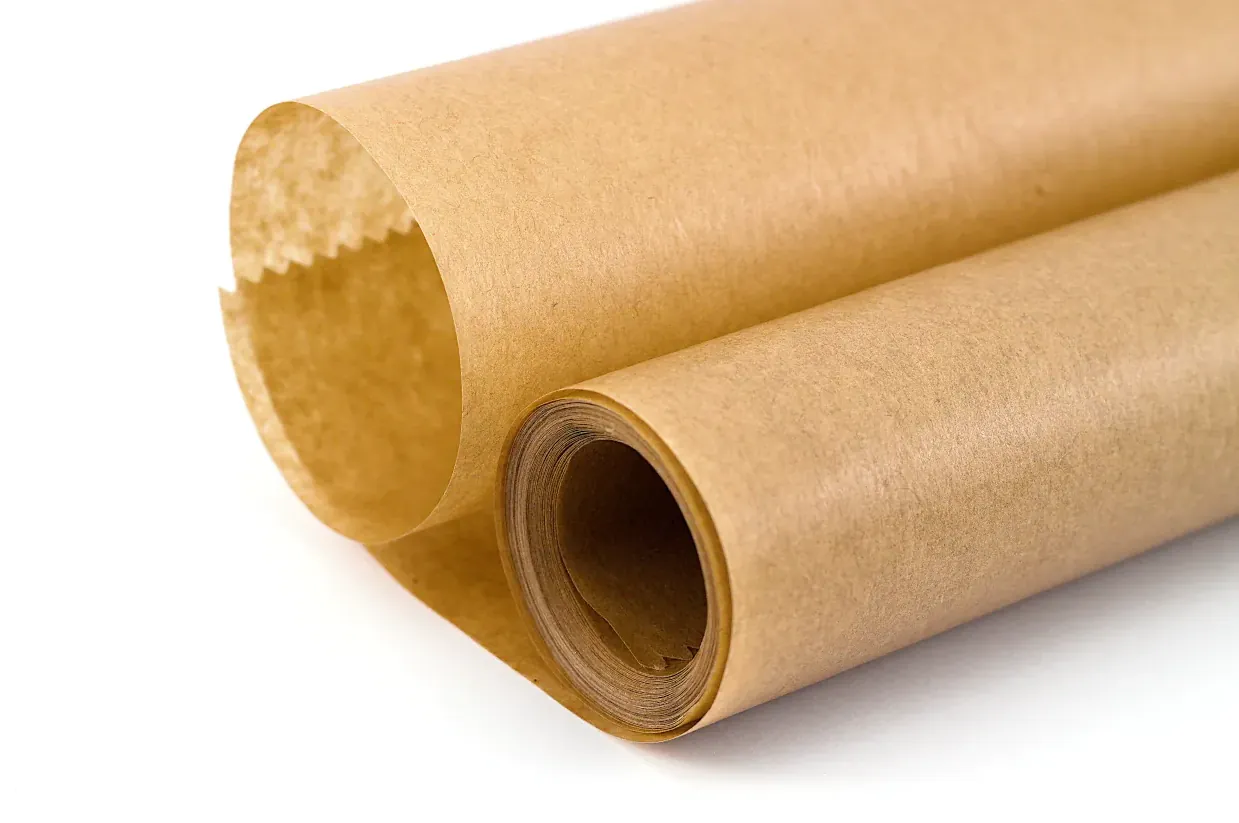
Those who want to buy eco-friendly products have the possibility of buying biodegradable parchment paper.
What is the difference between the normal kind and the biodegradable kind?
Parchment paper is usually categorized into bleached (the white kind) and unbleached (the brown kind).
In order to get compostable and biodegradable parchment paper, we simply have to buy the unbleached kind, the one that is brown in color.
The unbleached one will break down in 30 to 90 days and that’s why it’s biodegradable. The soil absorbs it and that’s it.
Bleached parchment paper needs to state explicitly on the packaging if it’s compostable, otherwise you can assume that it’s not.
Where to Buy?
Check Price and User Reviews Here
3. Silicone Baking Mats
Silicone baking mats are actually a very good alternative to parchment paper if we want to be more sustainable.
Thus, if we need to bake and we want to prevent the food from sticking we have a few options at our disposal: parchment paper, silicone baking mats or greasing the pans with butter/oil/spraying the surface with non-stick oil spray.
Silicone baking mats can be used for years to come. We just wash them, let them dry, store them, and then we take them out again when we need to bake something on a baking sheet.
Thus, silicone baking mats are an investment that lasts for years. You pay for them once and then you get to use the same baking mat for many years to come.
However, the disadvantage is that we can only use them on baking sheets.
With parchment paper, we can cut it in whatever shape and size we need to match our pans or air fryer baskets, etc.
We can’t get silicone baking mats to match different shapes and sizes.
They come in certain sizes and are rectangular so they go on baking sheets.
Some of the best making mats are the ones from Silpat, they’re my favorite.
Silpat is actually a brand that has a whole range of silicone baking products: half sheet baking mat, pizza silicone baking mat, baking mat for bread, a bunch of baking molds for muffins, brownies, mini loaf, round cake mold, and silicone countertop workstation mat.
Where to Buy?
Check Price and User Reviews Here
4. Recycled Aluminum Foil
If you’re actually searching for the best alternative to aluminum foil because you want an eco-friendly alternative, then let’s talk about recycled aluminum foil.
Of course, we’re also going to throw away the recycled foil once it’s used but at least we bought a product that was made from scrapes that would have accumulated in landfills or wherever else otherwise.
One of the most popular is the If You Care Aluminum Foil, which comes in a pack as one 50 sq ft roll.
It’s 100% recycled and 95% energy saving. The manufacturer states that their product uses 95% less energy to produce.
That’s because there’s no need to mine, which results in less waste, while reusing a precious resource.
Besides being recycled foil, it’s also 100% recyclable. It can be recycled again, with the condition that your local recycling center accepts aluminum foil.
Is it much more expensive? Not really so you won’t pay extra for the task of being eco-friendly with this particular product.
Another very good option is the Reynolds Wrap Recycled Aluminum Foil.
Personally, I prefer the Reynolds because it comes in a 200 sq ft roll so we don’t have to buy it all that often. It will last a long time.
Where to Buy?
Check Price and User Reviews Here
5. Beeswax Food Wraps: Best Alternative to Aluminum Foil for Wrapping Food
I love beeswax food wraps. Don’t get me wrong, wax paper also works well for wrapping, storing, and freezing foods but beeswax food wraps is the alternative we can buy.
Beeswax food wraps are described as being the best natural alternative to plastic wraps and sandwich bags.
We can use them to wrap up cheese, fruits, sandwiches, vegetables, cookies, etc.
Most packages will contain an array of sizes.
The other positive thing about using these eco-friendly wraps is that they’re reusable.
We just have to rinse the beeswax wraps with cold water and hang on to dry.
As long as we keep them away from heat, we can use the same wrap for a long while.
Where to Buy?
Check Price and User Reviews Here
6. Glass Food Storage Containers
If you’re in the habit of covering pots and pans with aluminum foil to store food in the fridge, then I present to you one of the best alternatives to aluminum foil: glass food storage containers.
Glass storage containers come with lids and they’re very easy to use.
Moreover, washing them is a lot easier than washing plastic containers, no matter what greasy delicious foods you store in them.
They come in sets of different shapes and sizes.
And the price for these sets is very decent, especially when you consider that we can use the same set for basically a lifetime.
All in all, you’ll love glass containers, especially when you can transfer extremely hot food in them without any worries.
Where to Buy?
Check Price and User Reviews Here
7. Silicone Lids
Another alternative to using aluminum foil for covering pots and pans is to use silicone lids.
And, unlike tin foil, silicone lids can also be used in the microwave to prevent splatters.
A set of silicone lids will include different sizes to match different sized bowls, pots, and pans.
The good ones hold their shape, are flexible yet easy to handle, place, and remove.
We can use them in a variety of situations: microwave, stove, oven, fridge. Or to serve food at the table.
Good silicone lids will fit most smooth rimmed containers, whether they’re made from metal, stainless steel, glass or plastic.
Just make sure to read which size the silicone lids are compatible with.
Most will be compatible with any pot, fry pan, glass, bowl up to 10 inches.
Where to Buy?
Check Price and User Reviews Here
8. LunchBots Stainless Steel Lunch Container
Last but not least in my recommendations for the best alternatives to aluminum foil is a stainless steel lunch box.
I should first mention that the LunchBots Stainless Steel Lunch Container is not very big. So, if you’re in the habit of taking a lot of food with you, this one is absolutely not a good pick.
On the other hand, if you just want a holder for a full sandwich, a nicely-sized wrap, a decent-sized salad, some pasta, noodle dishes or some cold cuts thrown in the box with some veggies, then it can be a great option.
You should only use it to pack solid food as it’s not water tight.
Its dimensions are 6 x 5 x 1.75 inches.
It also includes a lid.
The whole thing and the lid are made of stainless steel, highest quality 18/8 stainless steel. And it’s dishwasher-safe.
We could also say that it’s environmentally friendly. And it looks great. Plus, the small size is an advantage if you don’t want to carry a big box with you when you leave the house.
Where to Buy?
Check Price and User Reviews Here
What is aluminum foil?
Aluminum foil has a dull side and a shiny side, which occurs during the manufacturing process.
It all starts out with mining bauxite, which is the raw material in aluminum. Once aluminum is obtained through some complicated processes, the foil is produced by rolling aluminum through a continuous mill.
That makes the aluminum thinner and longer and in the end results in the foil we use in the kitchens.
Is aluminum foil eco-friendly?
In theory, we could say that it is eco-friendly, it’s not inherently bad for the environment because it’s made from aluminum.
Moreover, it breaks down fairly quickly and it can be recycled. As you saw, we can buy recycled aluminum foil as one of the best alternatives to aluminum foil, a substitute to the regular kind that involves mining for manufacturing it.
The problem isn’t with aluminum foil per se. If we consume too much, that high amount will accumulate in landfills. Which makes it not good for the environment. The problem is with our consumption.
Moreover, the fact that mining is needed for extracting bauxite, that also implies that it’s not eco-friendly.
If you want to read even more about how it impacts the environment, you can check out this article.
Best Uses for Aluminum Foil
Since we’ve seen which are some of the best alternatives to aluminum foil, let’s talk more about how we use foil so that we know which substitutes would work better depending on our situation.
Grilling or broiling or roasting calls for the use of aluminum foil. That’s because aluminum foil is heat resistant above 400 degrees F and it conducts and distributes heat.
If we want to make individual foil packs for dinner on the grill or over an open flame, then we need to wrap our food in foil.
That’s primarily how we use tin foil for cooking, grilling, broiling, and roasting.
Another use for aluminum foil is storing food.
The attractiveness of covering pans, bowls, containers, etc. with foil is that it molds around all surfaces, no matter their shapes or sizes.
It ensures a tight fit that keeps our air. The tight, snug fit that the foil forms over stored food prolongs freshness and locks in the smell so our fridge continues to smell neutral.
When we can’t use aluminum foil
We can’t use it in the microwave. Microwave ovens and metal don’t get along well.
It can cause sparks, which can transform into a fire.
Thus, if you want to cover a dish with something in the microwave to prevent splatters, use wax paper, parchment paper, beeswax food wraps or silicone lids.
All in all, using the best alternatives to aluminum foil depends on what we need these substitutes for, there are plenty of options to choose from, no matter your need.

